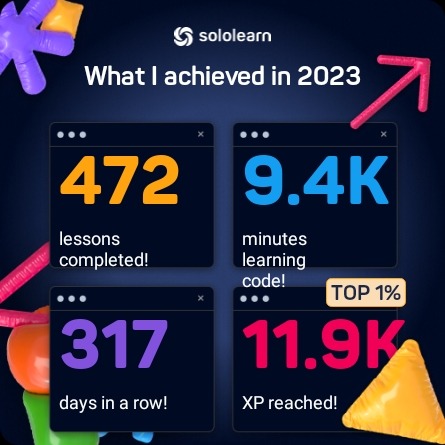The Python Institute ...
The Python Institute ...

Post #103: The Python Institute, The Language Of Today And Tomorrow, 2023.
More Posts from Python-programming-language and Others

SoloLearn was one of my favourite learning platforms for programming languages on the internet in 2023. I think my power, endurance and success time were awesome.
Post #109: My Progress on SoloLearn 2023, 2024
Python provides the date and the time ...
The source code of my exercise, part 1 ...


The output of my source code ...

The source code of my exercise, part 2 ...


Post #66: Free Exercise, The DateTime Module, Source: Michael Weigend, Programmieren lernen mit Python, MITP Verlag, Frechen, 1. Auflage, 2023.
Mu - A small but very comfortable IDE ...




Post #28: MU, An IDE for Python and absolute beginners. It's really a nice and helpful tool for learners of all ages, 2023.
Informatik - Unterrichtsmaterialien ...

Post #10: SwissEduc - Informatik, Materialien für den Informatik-Unterricht, 2023.
Introducing WebTigerPython | TigerJython

Post #157: WebTigerPython, An educational and python-like programming language for kids, youth and adults, 2025.
Wie schwer ist es, Python zu lernen?
Post #143: YouTube, Florian Dalwigk, Wie schwer ist es, Python zu lernen?, 2024.
Python Tutorial, #12 Logische Operatoren ...
The source code of my exercise, part 1 ...

The output of my source code ...

The source code of my exercise, part 2 ...


Post #45: YouTube, Programmieren-Starten, Python Crashkurs, #12 Logische Operatoren, 2023.
Turtle programming with Python: Sierpinski ...
Recursive Programming based on an idea by Sierpinski
The source code of my exercise, part 1 ...


The output of my source code ...

The source code of my exercise, part 2 ...


Post #40: Claudia Ermel & Olga Runge, Erste Schritte mit Python für Dummies Junior, Lass die Schildröte für dich arbeiten, Turtle Programmierung mit Python, Wiley Verlag, Weinheim, 2017.
100 Days Of Python: Try it out!
Attention: This Python Course is only suitable for those learners who have prior knowledge in Python, because there are a lot of advanced exercises.
Post #180: London App Brewery OR Udemy, Dr. Angela Yu, 100 Days Of Python, From Beginner To Professional Python Developer, 2024.
Post #90: The pillars of object-oriented programming: Object, Class, Inheritance, Polymorphism, Abstraction and Encapsulation, 2023.
The concept of object oriented programming explained
Object-oriented programming is a fundamental concept present in numerous programming languages such as C++, Java, JavaScript, and more. It becomes straightforward once you truly grasp it, and that's precisely what this post aims to help you achieve. So, stop your scrolling for a second and delve into this post for a thorough and clear explanation.

Understanding the Term "Object-Oriented"
To grasp OOP, let's begin by explaining the name itself: "Object-Oriented." This term signifies that OOP revolves around entities known as "objects."
What Exactly Is an Object?
An object in OOP is any entity that possesses both state and behavior. Consider a dog as an example: it has states such as color, name, and breed, while its behaviors encompass actions like wagging the tail, barking, and eating.
The reason we introduce the concept of objects in programming is to effectively represent real-world entities, a task that cannot be accomplished with conventional variables or arrays.
Classes: Abstract Forms of Objects
Now, what about classes? A class is essentially the abstract form of an object. If we take the example of a "dog," the object "Mydog" is a concrete instance, while the class "dog" represents dogs in a more general sense. Think of a class as a blueprint or template from which you can create individual objects.
Four Pillars of Object-Oriented Programming
Now that we've established the fundamentals of objects and classes. OOP is built upon four key principles:
Inheritance: Inheritance occurs when one object inherits all the properties and behaviors of a parent object. It promotes code reusability and facilitates runtime polymorphism.
Polymorphism: Polymorphism entails performing a single task in multiple ways. For instance, it can involve presenting information differently to customers or implementing different shapes like triangles or rectangles.
Abstraction: Abstraction is about concealing internal details while exposing functionality. Consider a phone call; we don't need to understand the intricate inner workings.
Encapsulation: Encapsulation involves bundling code and data into a single unit. Just like a capsule contains various medicines . In a fully encapsulated class (e.g., a Java bean), all data members are private, ensuring data integrity and controlled access.
I remember finding these images that explained these concepts using the 'Squid Game' series, and they are just perfect. So, I'm sharing them here and giving all credit to their owner :
Polymorphism , Inheritance , Encapsulation
-
 street--art--pics liked this · 1 year ago
street--art--pics liked this · 1 year ago -
 streetart-everywhere liked this · 1 year ago
streetart-everywhere liked this · 1 year ago -
 sandhot liked this · 1 year ago
sandhot liked this · 1 year ago -
 python-programming-language reblogged this · 1 year ago
python-programming-language reblogged this · 1 year ago
